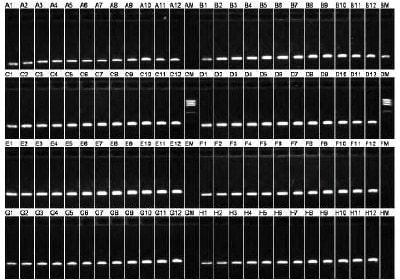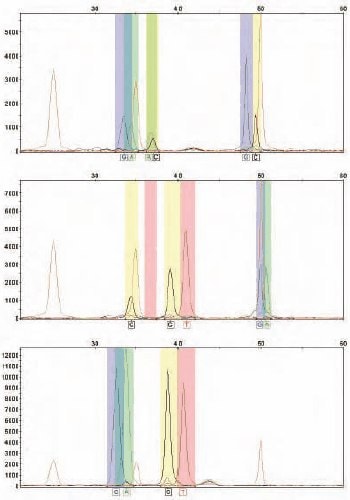Extract-N-Amp Reagent Provides a Highly Effective Way of Generating PCR Products from FTA® Blood Cards
Mairi J. Hunter<sup>1</sup>, Iain McLaren-Lee<sup>2</sup>, Nicholas R. Helps<sup>2</sup>
1The Sequencing Service, MSI/WTB Complex, University of Dundee, Dundee, Scotland, 2Sigma-Aldrich Corp., St. Louis, MO, USA
Abstract
Extract-N-Amp is a versatile, combined DNA extraction and amplification kit intended to simplify the generation of PCR products from a range of sample types. As shown in this article, this methodology can be used without modification to perform PCR on blood samples stored on FTA cards (Whatman). This removes the need for the laborious and costly washing procedures that the standard FTA protocol stipulates. Furthermore, this technique removes the otherwise inherent variability between sample preparations and maximizes the number of PCR reactions that can be performed on individual FTA card samples.
Introduction
FTA cards entrap and stabilize nucleic acids in a form that can be stored at room temperature for up to 11 years, shipped by post with no requirement for special handling, and used for subsequent sample analysis by PCR. DNA samples stored on FTA cards are traditionally prepared for PCR by subjecting a card punch to a series of wash steps designed to remove cell debris, followed by air drying. According to the manufacturer’s protocol, the wash steps take a minimum of 25 min (5 × 5 min) followed by drying for 1 hr at room temperature or 10 min at 56 °C. Each card punch can then be used to seed a single PCR reaction. When performing multiple PCR reactions per sample, e.g., on blood samples from multiple subjects, the time required for the preparation of the card punches for PCR is greatly amplified. Furthermore, as each PCR reaction requires a separate punch to be taken, each reaction is effectively being performed on a different DNA preparation even if derived from the same original blood spot. This requirement for multiple punches from each spot also creates a limit to the total number of reactions that can be performed on each of the potentially irreplaceable samples. In an attempt to overcome these problems, we used Extract-N-Amp for sample preparation and subsequent amplification of DNA fragments from blood samples stored on FTA cards.
Preliminary work on the project made use of the standard FTA methodology to process card punches prior to performing PCR reactions. The results of this work showed that it was impossible to achieve consistent levels of amplification from card punches even from the same blood sample. This lack of reproducibility between samples would be a major problem when sets of 96 samples were being processed. It was also obvious that the number of individual samples that would need to be processed would be a very time consuming and correspondingly expensive aspect of the study. We therefore sought a more effective methodology. While the Extract-N-Amp Kit is not specifically intended to extract and amplify DNA samples from FTA cards, we postulated that the kit might work on FTA cards.
Methodes
Neonatal blood samples from 96 subjects were spotted onto FTA cards. A single 2 mm disc punch was taken from each blood card and placed in a different well of a 96 well plate. 10 μL of Extract-N-Amp Extraction Solution was added to each well, the wells were sealed using a silicone mat, and the plate was spun down for a few sec to force the solution into the card. The card was then incubated at 55 °C for 15 min. 90 μL of Extract-N-Amp Neutralization Solution was then added to each well to stop the reaction. Twelve different primer pairs were used to amplify 100-300 bp regions of 12 cytokine related genes containing one or more single nucleotide polymorphisms (SNPs). PCR reactions were performed in 96 well PCR plates using 2 μL of each of the extracted samples in a total volume of 20 μL with 0.125 μM each primer, 0.5 mg/mL BSA and 1× Extract-N-Amp amplification mix. An initial step of 95 °C for 3 min was followed by 50 cycles of 95 °C for 30 sec, 60 °C for 30 sec and 72 °C for 30 sec. A final step of 72 °C for 10 min completed the PCR reaction. Following PCR, 5 μL of each PCR reaction was run on a 2% precast 96 well E-Gel® to determine yield and consistency of PCR amplification. Following treatment with 5 units of Exonuclease 1 and 5 units of Shrimp Alkaline Phosphatase for 60 min at 37 °C and subsequent inactivation of the enzymes for 15 min at 75 °C, the PCR products were used in SNP analyses using the SNaPshot® kit from Applied Biosystems according to the manufacturer’s instructions. SNaPshot products were analyzed on an Applied Biosystems model 3730 DNA analyser to identify the allelotypes.
Results and Discussion
We used the kit according to the supplied instructions. Figure 1 shows the result of agarose gel analysis of 96 PCR reactions performed using the Extract-N-Amp Kit on card punches of blood samples. As can be seen, highly reproducible and specific PCR products were generated. These products were of the correct size and DNA sequencing demonstrated that they were the correct PCR product (not shown). We then processed the PCR products and included them in single- or multi-plex SNaPshot reactions. The PCR products generated very clear and strong allele peaks (Figure 2).

Figure 1. An example agarose gel of a set of 96 PCR products. A 138 bp fragment from the Platelet Activating Factor Receptor gene was amplified. 5 μL of each PCR reaction was run on a 96 well 2% E-Gel. Negative (lane AM) and positive (lane BM) controls and a low mass marker (lanes CM and DM) were also run on the gel.

Figure 2. Each panel shows the informative region of a set of SNP results for one subject. The size marker is shown in orange and the peak sizes (in base pairs) are indicated. The SNP nucleotide color peaks are blue (G), red (T), black (C) and green (A). The top and middle panels show triplexed analyses of 3 SNPs each (Top: From left to right, interleukin (IL)10-1082 GA heterozygote, IL18-607 CA heterozygote and IL18-137GC heterozygote. Middle: From left to right, tumor necrosis factor alpha (TNFα)-376 C* homozygote, TNFα-238 CT* heterozygote and TNFα-308 GA heterozygote). The bottom panel shows a duplexed analysis of 2 SNPs (From left to right, IL1-511 AG* heterozygote and IL4-1902 CT* heterozygote). *Note that these SNPs were produced by using an interrogation primer on the reverse DNA strand. Hence, the actual SNP is the complement of that shown.
We experienced four key benefits associated with the use of Extract-N-Amp with FTA cards versus the traditional method.
- Samples that would not yield a PCR product by the traditional method worked in all cases when amplified using the Extract-N-Amp PCR reaction mix.
- This procedure took significantly less time than the traditional FTA method. There is only a 15-min incubation required prior to PCR using Extract-N-Amp compared to a minimum time of 90 min by the traditional method. Each Extract-N-Amp extraction also yielded enough template to seed up to 50 separate PCR reactions compared to the requirement, in this case, for 12 separate preparations from each sample by the traditional method.
- There was an improvement in the validity and reproducibility of these experiments as each of the 12 different PCR reactions could be performed on an identical template material.
- Significant financial savings were made in both reagent and labor costs due to the lack of need for repetition of template preparation.
The use of Extract-N-Amp to amplify PCR products from blood samples stored on FTA cards has been shown to be a reliable, simple and cost-effective alternative to the traditional protocol. The use of Extract-N-Amp is particularly appropriate when large numbers of PCR reactions are to be performed on a single isolate of sample, as it removes the need for multiple sample processing events at the start and produces an identical starting material for seeding multiple PCR reactions.
Acknowledgements
We greatly appreciate the cooperation of Dr. William McGuire, Associate Professor, Department of Paediatrics and Child Health, Canberra, Australia, for allowing us to publish these data.
Materials
To continue reading please sign in or create an account.
Don't Have An Account?